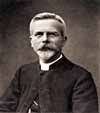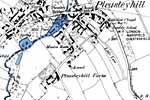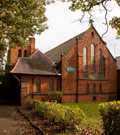For this church:    |
|
 The Rev H S Naylor The Rev H S Naylor |
At the time of its building the church could seat 250 people. The register dates from 1896, the same year that the church was consecrated. The first vicar of St Barnabus was the Rev. H.S. Naylor.
The act of creation of the new church was published in the London Gazette on 19 January 1897 and stated, amongst other details, that:
' ... the Ecclesiastical Commissioners for England, in pursuance of the Act of the fifty ninth year of His Majesty King George the Third, chapter one hundred and thirty-four; of the Act of the second and third years of Your Majesty chapter forty-nine; of the Act of the third and fourth years of Your Majesty, chapter sixty and of the Act of the nineteenth and twentieth years of Your Majesty chapter fifty-five, have prepared and now humbly lay before Your Majesty in Council, the following representation as to the assignment of a district chapelry to the consecrated church of Saint. Barnabas Pleasley Hill situate within the limits of the new parish (sometime district chapelry) of Saint John Mansfield in the county of Nottingham and in the diocese of Southwell.
Whereas it appears to us to be expedient that a district chapelry should be assigned to the said church of Saint Barnabas Pleasley Hill situate as aforesaid.'
 Mission Room shown Mission Room shownon map of 1879 Reproduced with the permission of the National Library of Scotland |
This new permanent structure was evidently preceded by a temporary mission room. Historic maps from 1879 show one standing on the south side of Crow Hill.
In 1908 the church was recorded as seating 305. In 1912, the net annual value of the living was rated at £201. The vicar was E.A. Berry, MA and the church seated 310. The Sunday School had 240 on the roll. There were 68 baptisms and 13 confirmations for the year ending 30 September 1912.
On Sunday, 25th July 1909, 'a painful sensation was caused at Pleasley Hill' by the sudden death of the Rev Clement Clove Ward. Ward, a curate at Staveley church in Derbyshire, was at the church to give the Sunday service as the new vicar, the Rev Edward A. Berry, had yet to take up residence. He was lodging at a house not far from the church and was found shortly before the evening service was due to begin 'sitting in his armchair in a perfectly natural position with his legs crossed, the manuscript of the sermon lying on the floor by his side. On making an examination the doctor came to the conclusion that death was due to natural causes.
The vicar from 1923-34 was the Rev Harold Goodrich whose greatest task was the provision of a new place of worship for the large recently-built Bull Farm housing estate on the north side of Mansfield. The building was erected at a cost of about £2,000 and was originally intended for use as a temporary church, a small sanctuary being attached for that purpose. It was dedicated in October 1928 and eventually became St Augustine's Church.
In 1962, the vicar of St Barnabas, Percy Powlesand, made national headlines for his progressive attitude toward pregnant brides and ‘shotgun weddings’. He was quoted in the Daily Mail as stating that ‘it is quite often true that those who experiment sexually before marriage make more faithful partners than those who pride themselves on having come to their marriage absolutely pure’. He had discussed the subject with probation officers, teachers, and parents and had written in his magazine that ‘I would much rather a pregnant bride was married in church than at a register office’ adding ‘I don’t want to give the impression that I approve of sexual experimentation before marriage, but I do not think it is anything like as bad as some people think’.
On 11 February 2013 the church was broken into and the metal safe stolen. Cash and valuables were not recovered but the church records were found in a litter bin and returned.
In 2014 there was no Sunday School but there was outreach to the young people of the parish through a summer play scheme, which had been running successfully for the last 18 years. There is a 10.30 Holy Communion service each week, with the fifth Sunday of the month a united service with St. Augustine’s, Mansfield. Services are generally Common Worship but the church sometimes also uses other forms of liturgy. There were no regular weekday services in 2014 but the Church family unites with St. Augustine’s for Lent and Advent Groups, the new ‘Faith and Fellowship’ group and for worship at significant times in the church year.






